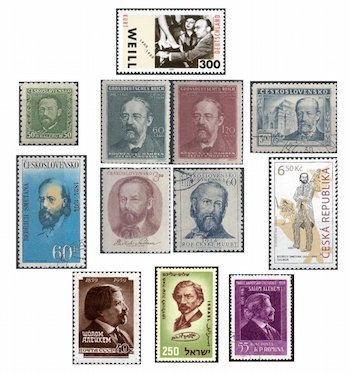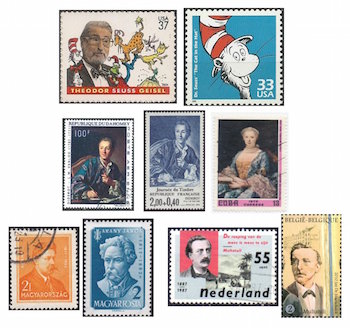The Arts on the Stamps of the World — March 2
An Arts Fuse regular feature: the arts on stamps of the world.

By Doug Briscoe
Today’s birthday people are composers Kurt Weill and Bedřich Smetana, writers Sholem Aleichem and Dr. Seuss, painter Louis-Michel van Loo, and two remarkable figures who I think should be better known, the brilliant Hungarian poet János Arany and the courageous Dutch writer Eduard Douwes Dekker, known as “Multatuli.”
As the collaborator of Bertolt Brecht, Kurt Weill (March 2, 1900 – April 3, 1950) is thought of primarily as the composer of cabaret and show tunes, but he also wrote much for the concert hall, especially in his younger days, including a symphonic poem after Rilke, two fine symphonies, a concerto for violin and winds, two string quartets, etc. His father was a cantor in his native Dessau, and Weill’s first preserved composition, written when he was 13, is a Jewish Wedding Song called “Mi Addir.” At 18 he went to the Berliner Hochschule für Musik, where he studied with Humperdinck, but soon gave up his studies there and returned to Dessau, becoming a répétiteur under Hans Knappertsbusch, no less. Ferruccio Busoni accepted Weill as one of a limited number of students, and while in Berlin Weill began teaching others, including Claudio Arrau, Maurice Abravanel, and Nikos Skalkottas. It was there that he met his first collaborator Georg Kaiser and his wife Lotte Lenya (to whom he was married twice, from 1926 to 1933 and again from 1937 to his death). He turned to writing for the musical theater and had great success with his songs for that medium and of course with The Threepenny Opera (1928). In 1933 Weill fled Nazism for Paris and then New York, working with the likes of Maxwell Anderson, Ira Gershwin, and Fritz Lang and taking US citizenship in 1943. He suffered a heart attack not long after his 50th birthday and died in New York City.

Bedřich Smetana (2 March 1824 – 12 May 1884) has the distinction of being the first individual composer ever represented on a commemorative stamp (as distinct from what is called a “definitive” stamp, one typically issued for day-to-day use, not for a specific occasion, and commonly in use for prolonged periods—our US flag stamps are an example). The very first postage stamps of any kind to honor composers were a set of seven issued by Austria in 1922, but these were for seven different composers and not for any particular anniversary. Images of Beethoven and Bach appeared on German stamps as early as 1926, but these were definitives, as were a Polish Chopin stamp of 1927 and a Hungarian Liszt stamp of 1932. The Smetana stamp I’m referring to—at upper left—was issued on March 26, 1934 specifically to mark the 50th anniversary of the composer’s death. Czechoslovakia went on to produce a number of Smetana stamps over the years. (The next to appear, however, came out during the German occupation in 1944. These are adjacent to the 1934 issue and labeled “Grossdeutsches Reich.”) Smetana’s birth name was Friedrich rather than Bedřich because German was at that time the official language of Bohemia under the Hapsburgs. In consequence, this (eventually) fiercely nationalistic composer did not learn proper Czech until he was nearly forty. His father, who had eighteen children from three wives, came to work as a brewer for Beethoven’s patron Count Waldstein and was an amateur musician who gave young Friedrich his first lessons. In Prague, Smetana was hired to teach music to the children of the then Count Thun, whose older family members had patronized Mozart and Haydn as well as Beethoven. He wrote patriotic works during the Revolution of 1848 and in the same year opened a piano institute, but in the mid-1850s began to suffer a series of emotional tragedies and setbacks: three of his four little daughters died in rather quick succession, his wife was diagnosed with tuberculosis, and his concerts and compositions were not receiving much acclaim. He went alone to Sweden, where he opened another school and was soon conducting the Gothenburg Society Orchestra. His father died in 1857 and his wife in 1859, but Smetana found some solace in the company of his friend and supporter Franz Liszt. His travails were not over, however, as in the 1870s he began to suffer from the composer’s bane of deafness. He had been back in Prague since 1861 and had composed his opera The Bartered Bride, but was completely deaf when he wrote his masterpiece, the cycle of six symphonic poems called “Má Vlast” (My Fatherland or My Country), and he subsequently descended into mental illness, dying in the Kateřinky Lunatic Asylum at the age of 60.
The man who wrote the stories that formed the basis for Fiddler on the Roof, Solomon Naumovich Rabinovich (March 2 [O.S. February 18] 1859 – May 13, 1916), experienced the ups and downs of fortune more than once. When he was born, his father was a rich merchant, but lost his wealth in a failed business venture, casting the family into poverty. His mother died of cholera when he was thirteen. Years later, when his successful writing career had restored his fortune, he lost it all in a stock speculation. It was later still (1894) that he wrote his Tevye the Dairyman stories, the works that inspired Fiddler on the Roof. Solomon’s earliest writing efforts included a Jewish version of Robinson Crusoe written when he was fifteen. His first published work appeared in 1883, and it was with that story that he assumed the pen name Sholem Aleichem, Yiddish for the Hebrew “shalom aleichem” (“peace be with you”). In less than a decade, his was a well-known name in Yiddish literature. In all, he wrote some forty books in the language. Driven by fear of pogroms, he came to New York in 1906, returned to Europe (Geneva) in 1908, and wound up in New York again in 1914, dying there two years later. His funeral is believed to have been attended by 100,000 people, one of the largest in New York’s history. Some other interesting facts about Sholem Aleichem: he was called “the Jewish Mark Twain”, to which Twain responded, “please tell him that I am the American Sholem Aleichem”; like Schoenberg, Aleichem was a triskaidekaphobe—his gravestone says he died on “May 12a”; his granddaughter Bel Kaufman was the author of Up the Down Staircase; last year a Web site was established to commemorate the centenary of his death.
Theodor Seuss Geisel (1904 – September 24, 1991) is also much better known by his pseudonym. He was born to the children of German immigrants in Springfield, Massachusetts and starting using his middle name so he could continue secretly writing for a Dartmouth College humor magazine after he was discovered drinking gin (during Prohibition!) on the premises. He also attended Oxford (Lincoln College), where he met his future wife Helen Palmer, also a writer of children’s books. Geisel was in the earlier years more of an illustrator and cartoonist than a writer, but he did publish four books prior to World War II, during which he was active as a political cartoonist. He also co-wrote with his wife the script for a film, Design for Death, which won the 1947 Oscar for Documentary Feature! (Betcha didn’t know that!) Horton Hears a Who! came out in 1955, The Cat in the Hat and How the Grinch Stole Christmas! in 1957, and Green Eggs and Ham in 1960. A Dr. Seuss National Memorial Sculpture Garden opened in Springfield in 2002.

On January 14th, we paid tribute in these pages to Jean-Baptiste van Loo, who was the father of today’s subject Louis-Michel van Loo (1707 – 20 March 1771). These were two members of a French family of painters of Dutch origin. This particular van Loo was court painter to Spanish King Philip V from 1736 to 1753. While at Madrid, he was one of the founders of the Royal Academy of Fine Arts of San Fernando. Back in Paris, he painted many portraits of Louis XV of France and other luminaries, including his famous portrait of Denis Diderot, seen here on stamps of France and Dahomey. The one from Cuba is labeled simply Portrait of a Woman, and I wasn’t able to learn any more about it.
János Arany (JAH-nosh AW-ra-nee; 1817—22 October 1882) is one of the most admired of Hungarian poets. He took easily to languages and as a child sought out anything he could find in Latin. Later he studied German and French and somewhere along the way picked up classical Greek, English, and Russian. He made what are considered to be the finest translations into Hungarian of Shakespeare’s Hamlet, A Midsummer Night’s Dream, and King John, and also translated Aristophanes, Lermontov, Pushkin, and Molière. As a poet he composed more than forty ballads—some have called him the “Shakespeare of ballads”—and a grand historical trilogy on the subject of the legendary Miklós Toldi, a hero of the 14th century. A second trilogy on the Huns was left incomplete at his death. Only Part One, “The Death of King Buda” (1864), was finished. Arany was a good friend of Sándor Petőfi and secretary-general of the Hungarian Academy of Sciences from 1865. Of his poem “Dante” the erudite Peter Ustinov said that it was “one of those few verses in Western literature that can seize concisely the whole meaning and transcendency of human life.”
Eduard Douwes Dekker (1820 – 19 February 1887) was a man uncompromising in his drive for social justice. Born in Amsterdam, Douwes Dekker in 1848 went to work as a civil servant in the Dutch East Indies (Java), where he rose to a rather prominent position as assistant resident throughout the Dutch colonies and was thus well placed to observe the abuses of the system. When he spoke out about them, he was threatened with dismissal and resigned. Back in the Netherlands he immediately began writing articles and pamphlets exposing colonial injustices, but hit home only with his satirical novel Max Havelaar (1860). Attempts were made to suppress this book, but it achieved fame throughout Europe, whereupon the vested interests tried to discredit the book as hyperbole. At this time Douwes Dekker adopted the pen name “Multatuli” (from Latin multa tuli, “I have suffered much”) and wrote a lot more, including another satirical work with the misleading title Love Letters (1861), another novel, Woutertje Pieterse (Little Walter Pieterse) and many short pieces that he collected together in seven volumes of Ideas (1862-77). He appears on Sigmund Freud’s 1907 list of “ten good books,” and in 2002, the Society of Dutch Literature named Multatuli the most important Dutch writer in history.
A graduate of the University of Massachusetts with a B.A. in English, Doug Briscoe worked in Boston classical music radio, at WCRB, WGBH, and WBUR, for about 25 years, beginning in 1977. He has the curious distinction of having succeeded Robert J. Lurtsema twice, first as host of WGBH’s weekday morning classical music program in 1993, then as host of the weekend program when Robert J.’s health failed in 2000. Doug also wrote liner notes for several of the late Gunther Schuller’s GM Recordings releases as well as program notes for the Boston Classical Orchestra. For the past few years he’s been posting a Facebook “blog” of classical music on stamps of the world, which has now been expanded to encompass all the arts for The Arts Fuse.
